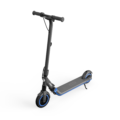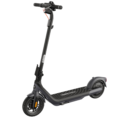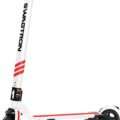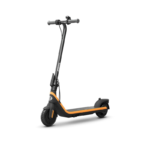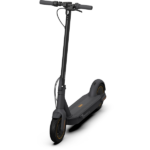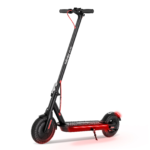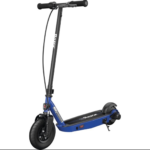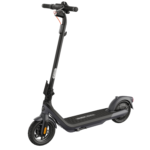- Home
- Scooters
- Electric Scooters
- Segway Ninebot E2
Segway Ninebot E2
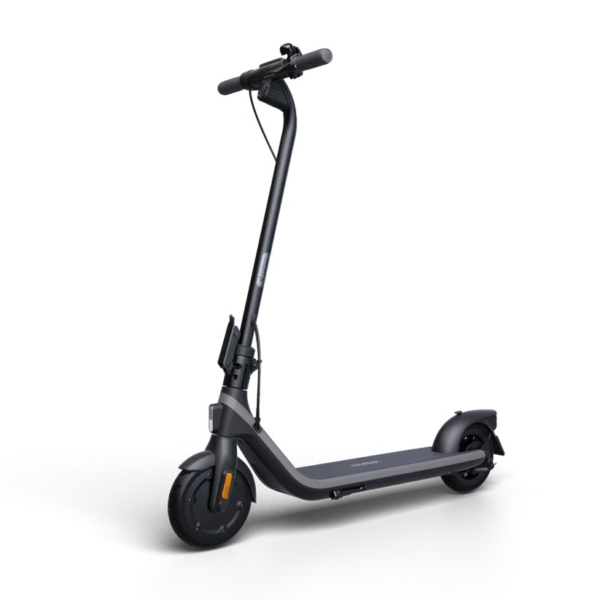


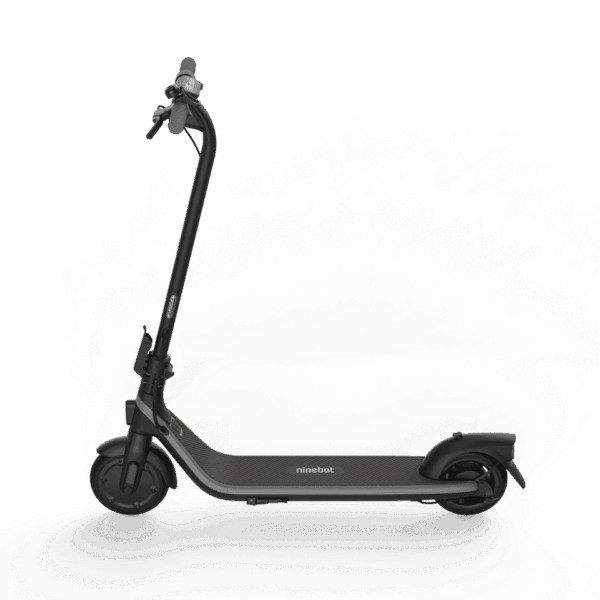
- Battery Range: 25 km (15.5 mi)
- Top Speed: 20 km/h (12.4 mph)
- Motor Power: 250 W
- Weight Capacity: 90 kg (198 lb)
- Charging Time: Approx. 7.5 h
- Scooter Weight & Portability: 14.2 kg (31.3 lb)
PROS
- Light 14.2 kg for easy carry
- Maintenance-free inner-hollow tires
- Dual brakes with rear drum
- Clear 2.8-inch LED dashboard
- IPX4 body / IPX6 battery
- Great value for short urban trips
CONS
- No suspension
- 20 km/h top speed cap
- Modest range for longer commutes
- Front-wheel drive can slip on wet paint
- Small 8.1-inch wheels on rough roads
- Non-removable battery
Overview: What the Segway Ninebot E2 Is Built For
Moreover, The Segway Ninebot E2 focuses on easy city travel, not extreme speed. It feels calm, compact, and friendly from the first ride. It turns quickly, stops cleanly, and folds fast. It also keeps maintenance light.
Additionally, The recipe is simple: a 250-watt front-hub motor, a 220 Wh battery, and inner-hollow tires. That trio delivers predictable power and low running costs. It suits students, first-time riders, and commuters who ride short distances.
Furthermore, You can carry the scooter with one hand when needed. You can roll it into elevators and trains. You can store it beside a desk. The E2 stays helpful every day because it is light and tidy.
Design and Build: Simple, Solid, and Compact
Consequently, The frame uses aluminum alloy with a secure latch. The stem locks firmly and resists flex. The low deck improves stability and reduces fatigue at stoplights.
Therefore, The 8.1-inch inner-hollow tires avoid flats. They add a hint of compliance compared to solid rubber. They still feel firm, so you slow on rough brick, yet you keep rolling without tube patch kits.
However, The LED dashboard is bright and simple. You see speed, mode, and battery at a glance. Clear information helps you ride with attention on the path, not the controls.
Performance: Calm Acceleration and Regulated Speed
Meanwhile, The 250 W motor gives measured thrust. Off the line it moves with purpose, but it does not lurch. Beginners can modulate the thumb throttle easily.
Also, The top speed is limited to 20 km/h. That figure aligns with common EU rules and many campus guidelines. On mixed paths the limit feels relaxed and safe.
In addition, Front-wheel drive keeps steering light. Yet painted lines can be slick in the rain. You roll on the throttle gently at crosswalks and stay centered for grip.
Battery, Range, and Charging: Built for Short Daily Loops
As a result, The 220 Wh battery targets short daily loops. On flat routes many riders see 20–25 km per charge. Headwinds, hills, and winter reduce that number.
Even so, Charging takes roughly seven and a half hours from near empty. Overnight top-ups keep the routine simple. You plug in at home or at the office and start fresh next ride.
For example, The Smart BMS monitors temperature, current, and voltage. It protects the pack and helps it age well. Sensible storage around 40–60% also preserves health.
Ride Quality and Comfort: Stable and Predictable
Because of this, There is no suspension, yet the ride stays friendly on smooth asphalt. The low deck lowers your center of mass and calms the chassis.
On the other hand, Inner-hollow tires mute sharp edges better than fully solid rubber. Still, you slow on cobbles and broken pavement. Bent knees and a relaxed stance absorb chatter.
Notably, The deck grip is coarse and secure in drizzle. A natural stance with one foot angled and one foot across the deck reduces fatigue on longer trips.
Braking, Safety, and Visibility: Predictable Stops and Bright Lights
In practice, Stopping power comes from a front electronic brake and a rear drum. The electronic system provides smooth deceleration with minimal upkeep.
Moreover, The drum brake works well in the wet because it is enclosed. Grit stays out, and the lever feel remains consistent. That reliability builds confidence.
Additionally, Lighting is strong for the class. A 2.1-watt headlight and a dedicated rear brake light improve visibility. Certified reflectors add passive safety at night.
Portability and Storage: Light, Quick, and Apartment-Friendly
Furthermore, Portability is a headline feature. At 14.2 kg the scooter is easy to carry up a flight of stairs. The fold is quick, and the profile is compact.
Consequently, In small flats and offices, storage is painless. The E2 leans by the door, slides under tables, and tucks beside desks. Commuters can board trains without fuss.
Therefore, The kickstand is stable, and the latch stays positive after many cycles. That consistency matters when you fold and unfold several times a day.
Smart Features and App: Helpful Tools Without Complexity
However, The Segway-Ninebot app connects over Bluetooth. It offers firmware updates, ride stats, and a simple electronic lock that resists rolling when engaged.
Meanwhile, Cruise control helps on longer straight paths. You set a steady speed and relax your thumb. You still remain alert and ready to brake.
Also, The app’s tutorials support new riders. Short guides on stance, braking, and cornering help you build skills before riding in busy areas.
Maintenance: Low Upkeep by Design
In addition, Inner-hollow tires eliminate tube punctures, which reduces downtime. You inspect for cuts occasionally and keep riding.
As a result, The drum brake needs little attention compared to discs. The electronic brake has no pads. Monthly checks for hinge play and fasteners keep things tidy.
Even so, After wet rides, you wipe the scooter dry. You avoid pressure washers and deep puddles. These habits protect bearings, switches, and connectors.
E2 vs E2 Plus vs E2 Pro: Picking the Right Trim
For example, The base E2 delivers the best portability and price in the family. It fits short, flat routes and riders who value simplicity.
Because of this, The E2 Plus adds minor power or trim changes depending on region. It may feel slightly stronger off the line while staying compact.
On the other hand, The E2 Pro raises both power and capacity for longer rides and steeper terrain. It suits hillier cities and weekend loops that exceed 20 km.
Range Tips: Get More Kilometers from Every Charge
Notably, Smooth inputs stretch distance. Gentle throttle and early coasting avoid waste. You time lights and preserve momentum.
In practice, Route choice matters. A slightly longer path with fewer stops can use less energy than a short route with heavy traffic.
Moreover, Wind and cold lower range. On breezy days, tuck in a little. In winter, store and charge indoors when possible.
Comfort and Safety Add-Ons: Small Accessories, Big Benefits
Additionally, A phone mount near the stem keeps maps secure and visible. You avoid one-handed glances at pockets and stay focused.
Furthermore, A bright bell with a clear tone makes passing predictable. Polite signals keep paths friendly for everyone.
Consequently, Thin full-finger gloves cut hand fatigue in cool weather. A clip-on rear flasher increases visibility in dusk traffic.
Limitations: Honest Trade-Offs That Keep Weight and Cost Low
Therefore, The scooter is capped at 20 km/h and runs a small battery. It is not built for long highway-adjacent bike lanes.
However, With 8.1-inch wheels and no suspension, rough surfaces feel busy. You slow down on bricks and patched asphalt.
Meanwhile, Front drive can slip on wet paint if you hammer the throttle at walking speed. Smooth inputs fix the issue.
Best Use Cases: Commutes, Campus, and Neighborhood Errands
Also, Short commutes between two and eight kilometers are ideal. You roll from home to a station, or from class to class, with minimal effort.
In addition, Quick errands are easy. You stop by a small shop, fold the scooter, and step inside without blocking aisles.
As a result, Weekend rides on riverside paths feel relaxed. You explore new coffee spots while keeping the pace social and calm.
Be Seen, Be Predictable: Visibility and Etiquette
Even so, Bright clothing and reflective bands improve night safety. You stand out to drivers approaching from the side.
For example, Mount the headlight slightly down to avoid glare for others. A clear light pattern helps you pick clean lines at speed.
Because of this, Check local rules for path usage and speed limits. Compliance keeps access open for all riders.
Owner Experience: From First Ride to Daily Habit
On the other hand, New owners report easy setup and intuitive controls. The throttle feel is linear, and the brake levers are light.
Notably, After a few weeks, routines become automatic. You fold by feel, lift cleanly, and charge on habit each night.
In practice, Costs stay low because consumables last. Tire issues are rare, and brake maintenance is infrequent.
Specs Snapshot: Numbers That Matter on the Path
Moreover, Key data points define the experience: 250 W nominal motor, 20 km/h limit, 220 Wh pack, and 14.2 kg weight.
Additionally, The scooter handles up to 90 kg rider weight. It climbs short grades up to about twelve percent with a running start.
Furthermore, The body carries IPX4 protection, and the battery enclosure is rated IPX6. Light rain rides are realistic with care.
Sustainability: Small Scooter, Real-World Impact
Consequently, Short e-scooter trips replace many car starts. You reduce emissions, noise, and parking stress in tight streets.
Therefore, Because the E2 charges from a regular outlet, energy costs stay tiny. A few cents power most daily loops.
However, As infrastructure grows, scooters blend with buses, trams, and trains. Multimodal travel becomes smooth and affordable.
Fit and Ergonomics: Roomy Cockpit for Most Adults
Meanwhile, Riders around 160–185 cm usually find the cockpit comfortable. The straight bar and open stance create room for shoulders and elbows.
Also, Taller riders can still ride short distances without strain. For all-day comfort, a larger model with a higher bar may suit better.
In addition, The deck supports a stable sideways stance that eases pressure on joints during longer city loops.
Security and Storage: Simple Steps That Protect Your Scooter
As a result, Use the app lock for quick coffee stops. For longer breaks, add a compact lock through the frame where rules allow.
Even so, Store the scooter indoors when possible. Dry spaces protect wiring and keep the finish looking fresh.
For example, Record the serial number and keep purchase details handy. Documentation speeds service if you ever need parts.
Final Verdict: A Trustworthy First Scooter for Daily Life
Because of this, The Segway Ninebot E2 focuses on what matters for short city travel: low weight, easy handling, and consistent performance.
On the other hand, It will not break speed records, and that is fine. It keeps costs low and confidence high for new and returning riders.
Notably, If your routes are short and mostly flat, the E2 is an easy recommendation. It is dependable, tidy, and pleasant to live with.
Commuting Scenarios: How the E2 Handles Real Streets
In practice, On mixed bike lanes with morning traffic, steady acceleration and predictable brakes reduce stress. You keep a calm, even pace.
Moreover, At junctions with frequent red lights, light weight helps with quick restarts. You push once, roll, and apply a gentle throttle.
Additionally, On shared paths with pedestrians, the capped top speed and the clear bell tone support courteous passing. You ride defensively.
Setup and First Ride Checklist
Consequently, Unbox and inspect the frame, latch, grips, and wiring. You confirm nothing is loose and nothing rubs.
Therefore, Charge the battery to full before the first trip. The BMS balances cells during the first few cycles.
However, Practice starts, stops, and slow turns in an empty lot. You refine stance before mixing with traffic.
Riding in Weather: Rain, Wind, and Cold
Meanwhile, In light rain, reduce speed, extend braking distance, and avoid paint lines at acute angles. Traction stays manageable with smooth inputs.
Also, In strong crosswinds, lower your elbows and keep a supple grip. You let the scooter move slightly rather than fighting it.
In addition, In winter, store and charge indoors. Cold reduces available energy temporarily, so plan conservative routes.
Accessories: Practical Upgrades for Daily Use
As a result, A compact front bag carries a charger, wallet, and a small lock. Balanced weight at the stem keeps handling predictable.
Even so, A reflective vest or ankle bands add visibility. Motion draws attention at night more than color alone.
For example, A sturdy phone mount with a mechanical clamp resists bumps better than elastic bands. Navigation stays readable.
Simple Maintenance Schedule
Because of this, Weekly, check the latch, the kickstand bolt, and the brake feel. Minor adjustments preserve that new-scooter tightness.
On the other hand, Monthly, clean the hinge area and inspect the tire surfaces for cuts or embedded debris. You remove grit before it spreads.
Notably, Seasonally, check fasteners across the bar, stem, and deck. A careful once-over prevents creaks and play.
Charging Best Practices
In practice, Use the stock charger on a stable outlet. Avoid extension cords where possible to reduce voltage drop.
Moreover, Unplug after a full charge for daily use. Long float times add little value and heat the pack needlessly.
Additionally, If you will store the scooter for weeks, leave the battery near half. You return and resume without a deep cycle.
Safety Culture: Habits That Pay Off
Consequently, Make eye contact with drivers at junctions. You confirm they see you before you cross.
Therefore, Signal early and hold the line through turns. Predictability reduces surprises for everyone nearby.
However, Keep earbuds out in traffic. You need to hear bells, bikes, and cars approaching from behind.
Troubleshooting: Quick Answers to Common Questions
Meanwhile, If the scooter will not power on, check the charger connection and the battery level. Then verify the latch sensor is seated.
Also, If braking feels weak, inspect the rear drum cable for slack. A small adjustment restores lever feel.
In addition, If range drops suddenly in cold weather, warm the scooter indoors and charge fully. Capacity rebounds as cells return to room temperature.
Rules and Compliance: Know Your Local Limits
As a result, Many cities limit speed to 20 km/h on shared paths. The E2 aligns with that cap by default.
Even so, Some areas restrict sidewalk riding. You choose bike lanes where marked and yield to pedestrians when required.
For example, Lighting and reflectors may be mandatory after dark. The E2 ships ready, yet extra lights still help.
Who Should Buy the E2—and Who Should Not
Because of this, Buy the E2 if your rides are short, flat, and frequent. You want low weight, low cost, and low stress.
On the other hand, Consider a higher-powered model if your city has long, steep climbs or if you carry loads daily.
Notably, Skip scooters entirely if your paths are unlit rural roads with fast car traffic. A bike with large wheels may be safer there.
Car and Transit Travel: Packing the E2
In practice, In small hatchbacks, the folded E2 lies flat in the cargo area. A simple mat keeps dirt off seats.
Moreover, On trains and trams, hold the stem and face the bar inward to save space. You keep the deck clear of feet.
Additionally, At offices, place the charger and a microfiber cloth in a small drawer. Clean storage keeps the scooter presentable.
Cost of Ownership: Tiny Daily Costs, Predictable Wear
Consequently, Electricity use is minimal. A few cents of power cover common daily trips, even with some headwind.
Therefore, Consumables last. Tires resist punctures, and drums avoid rotor bends. You spend more time riding than wrenching.
However, Resale value holds because Segway supports parts and updates. A maintained E2 remains attractive to new riders.
Shared Path Etiquette: Ride Calm, Share Kindly
Meanwhile, Slow when passing walkers and ring early. A friendly tone and space make everyone comfortable.
Also, Yield to bikes moving faster than you. Keep right where that is customary and hold a straight line.
In addition, Avoid weaving. Smooth, predictable paths prevent conflicts and keep your average speed steady anyway.
What to Carry: A Minimalist Rider Kit
As a result, Bring a small lock, the charger, and a short USB cable. You solve most day-to-day needs with that trio.
Even so, Add a compact multi-tool with hex keys and a Phillips head. Occasional lever or clamp tweaks are quick.
For example, Pack a microfiber cloth for rainy days. You wipe the deck and grips before storing the scooter indoors.
Long-Term Storage: Keep the Battery Happy
Because of this, Store around half charge in a cool, dry place. Check the level every month and top to 60% if needed.
On the other hand, Avoid direct sun in parked cars. Heat accelerates aging in cells and plastics.
Notably, Wake the scooter gently after long storage. Charge fully and ride short loops before resuming longer trips.
Skill Building: Simple Drills That Improve Control
In practice, Practice slow-speed figure eights in an empty lot. Balance improves, and tight turns feel natural.
Moreover, Rehearse emergency stops from 15 km/h. You learn lever pressure and weight shift without panic.
Additionally, Work on scanning. Every ten seconds, check mirrors or look over a shoulder where safe. Situational awareness grows.
Environmental Notes: Respect the Spaces You Ride
Consequently, Keep to marked paths and avoid soft ground. Tires can damage park lawns after rain.
Therefore, Give wildlife plenty of room in green corridors. Bells are for people, not for animals.
However, Dispose of packaging and worn parts responsibly. Many cities offer e-waste collection points.
Integrate with Public Transport: Make Multimodal Easy
Meanwhile, Plan a route that links a short scooter leg to a frequent tram line. You reduce travel time and stress.
Also, Check station rules on scooters. Most allow folded units, yet some require covers during peak hours.
In addition, Use apps to watch real-time arrivals. You leave home at the right minute and avoid long platform waits.
Guidance for Teen Riders: Keep It Safe and Smooth
As a result, Review local rules together before the first ride. Clear expectations prevent surprises on the path.
Even so, Start with supervised practice in a car-free area. Skills build fast with feedback and calm coaching.
For example, Set simple house rules for night riding, helmets, and phone use. Consistency builds good habits.
Scooter vs Bicycle for Short Trips
Because of this, A scooter folds and fits indoors more easily. You avoid theft exposure outside.
On the other hand, A bicycle rolls faster on rough surfaces thanks to large wheels and gears. Yet it is harder to carry upstairs.
Notably, For two to eight kilometer trips on smooth paths, the E2 feels simpler. You step on, glide, and fold at the door.
Specifications
General
| Model The Model specifies the exact version or name of the scooter. It helps identify its unique design, features, and specifications within the manufacturer’s product line. Knowing the model makes it easier to compare options, find compatible accessories, or look up support information. | Ninebot E2 |
| Brand The Brand identifies the manufacturer or company that designs and produces the scooter. A trusted brand is a sign of quality, reliability, and good customer support. Well-known brands often have higher standards for safety, performance, and after-sales service, giving you more confidence in your purchase. | Segway |
| Release Date The Release Date indicates when the scooter model was officially launched on the market. This helps you know how current the design, technology, and features are. A newer release date often means updated components, improved performance, and the latest safety or smart features. | 17 November 2025 |
| Recommended Age Recommended Age indicates the minimum age range that the scooter is designed for, based on safety, size, and ease of use. Following the recommended age helps ensure that riders can handle the scooter’s speed, weight, and controls comfortably and safely. Always check local laws and use protective gear, especially for younger riders. | Recommended 14+ |
Performance & Power
| Motor Power (Wattage) What it means: The motor power, measured in watts (W), shows how strong the scooter’s electric motor is. Why it matters: Higher wattage usually means better acceleration, more torque, and improved performance on hills or rough terrain. For example, a 250W motor is good for flat city roads and light riders, while a 500W or 1000W motor provides more power for faster speeds or climbing steep inclines. | 250 W nominal (up to 450 W peak) |
| Top Speed The Top Speed indicates the maximum speed that the scooter can reach under optimal conditions. It’s usually measured on level ground with a fully charged battery and an average rider weight. A higher top speed allows you to travel longer distances faster, but always ensure you ride within legal speed limits and your personal comfort zone for safety. | 20 km/h (12.4 mph) |
| Battery Capacity Battery Capacity refers to the total amount of energy the scooter’s battery can store, usually measured in ampere-hours (Ah) or watt-hours (Wh). A higher battery capacity means you can ride longer distances on a single charge, reducing the need for frequent recharging. Keep in mind that actual range can vary depending on rider weight, terrain, speed, and weather conditions. | 220 Wh (21.6 V, 10.2 Ah) |
| Estimated Range per Charge The Estimated Range per Charge indicates the average distance the scooter can travel on a single full battery charge. This range is calculated under optimal conditions, such as flat terrain, moderate speed, and average rider weight. Real-world range may vary depending on riding style, terrain, weather, and load. A longer range means fewer recharges and greater freedom for longer trips. | Up to 25 km (15.5 mi) |
| Hill Climb Ability Hill Climb Ability describes the maximum incline or slope that the scooter can handle while maintaining stable performance. It’s typically expressed as a percentage or in degrees. A higher hill climb rating means the scooter can tackle steeper hills without losing too much speed or power. Actual climbing performance may vary based on rider weight, battery charge, and terrain conditions. | Up to 12% grades |
| Drive System The Drive System refers to how power from the motor is delivered to the wheels. Electric scooters typically use either a hub motor (directly integrated into the wheel) or a chain/belt drive system. A high-quality drive system ensures smooth acceleration, efficient power transfer, and low maintenance. The choice of drive system affects performance, noise level, and overall ride experience. | Front hub motor (FWD) |
Charging & Electrical
| Charging Time Charging Time indicates how long it takes to fully recharge the scooter’s battery from empty to 100% using the standard charger provided. Faster charging means less downtime and more time on the road. Actual charging time may vary slightly depending on battery capacity, charger output, and environmental conditions. | Approx. 7.5 hours |
| Battery Type Battery Type refers to the specific technology used in the scooter’s battery, which affects performance, lifespan, weight, and charging time. Most modern electric scooters use high-quality lithium-ion (Li-ion) batteries because they offer a good balance of energy density, durability, and low maintenance. A reliable battery type ensures consistent power delivery and longer riding ranges. | Lithium-ion with Smart BMS |
| Removable Battery A Removable Battery means the battery pack can be easily detached from the scooter for convenient charging and replacement. This feature allows you to charge the battery separately, swap it with a spare for extended range, or securely store it indoors in extreme weather. Removable batteries add flexibility and make it easier to keep your scooter powered up wherever you are. | No |
| Regenerative Braking Regenerative Braking is an energy-saving feature that converts some of the energy normally lost during braking back into battery power. When you slow down or brake, the motor works in reverse to generate electricity, which helps extend the scooter’s range and improves overall efficiency. This system also reduces wear on traditional brake components, leading to lower maintenance over time. | Yes (regenerative electronic brake) |
| Lighting Lighting refers to the built-in front and rear lights that enhance visibility and safety when riding in low-light conditions or at night. Good lighting helps you see the road ahead and ensures that other road users can see you. Many scooters include LED headlights, taillights, and sometimes brake lights or side reflectors for added safety and compliance with local traffic regulations. | 2.1 W front LED + rear LED brake light |
Build & Dimensions
| Scooter Weight Scooter Weight refers to the total weight of the scooter when fully assembled, including the battery. This affects how easy it is to carry, lift, and store the scooter when not in use. A lighter scooter is more portable and convenient for commuting, especially if you need to carry it upstairs or onto public transport. Keep in mind that a sturdy frame and quality components may add to the weight but also contribute to better durability and ride stability. | 14.2 kg (31.3 lb) |
| Maximum Rider Weight Maximum Rider Weight indicates the highest rider weight that the scooter is designed to safely support while maintaining optimal performance and stability. Staying within this limit helps ensure reliable acceleration, braking, and climbing ability, and it protects the frame, suspension, and motor from excessive strain. Exceeding the recommended limit may reduce performance and increase wear on components. | 90 kg (198 lb) |
| Deck Size Deck Size refers to the dimensions of the scooter’s standing platform. A wider and longer deck provides more foot space, allowing you to stand comfortably and adjust your stance while riding. A well-sized deck improves balance and stability, especially on longer rides or at higher speeds. Compact decks, on the other hand, help keep the scooter lightweight and portable. | Low-profile deck (compact) |
| Handlebar Height Handlebar Height refers to the distance from the deck to the handlebars, which affects your riding posture and comfort. An appropriate handlebar height helps you maintain good balance, reduces strain on your back and arms, and makes steering more comfortable. Some scooters have adjustable handlebars to fit riders of different heights, while others have a fixed height for a streamlined design. | Adult-friendly fixed height |
| Folding Mechanism The Folding Mechanism describes how easily and securely the scooter can be folded for carrying and storage. A well-designed folding system lets you quickly collapse the scooter into a compact size, making it convenient to transport on public transit, store under a desk, or fit into a car trunk. Look for sturdy latches and safety locks to ensure the scooter stays firmly in place when folded or unfolded. | Quick folding latch |
| Dimensions Folded Dimensions indicate the size of the scooter when it’s fully folded. This measurement shows how much space the scooter will take up when stored or carried, making it easier to check if it will fit in your car trunk, under a desk, or in a closet. Compact folded dimensions are ideal for commuters who need to bring their scooter on public transport or store it in tight spaces. | 1140 × 445 × 500 mm (folded) |
| Material Material refers to the primary construction materials used for the scooter’s frame and key components. High-quality materials like aircraft-grade aluminum, reinforced steel, or durable composites provide strength, stability, and a lighter overall weight. A sturdy material ensures the scooter can handle daily wear and tear while maintaining safety and performance. | Aluminum alloy |
Safety & Control
| Brake Type(s) Brake Type(s) describe the braking systems the scooter uses to help you slow down or stop safely. Common brake types include mechanical brakes (like drum or disc brakes), electronic brakes, and foot brakes. Many scooters combine multiple braking systems for added safety and shorter stopping distances. The type and quality of brakes affect your control, especially when riding at higher speeds or on slopes. | Front electronic + rear drum |
| Suspension Suspension refers to the system that absorbs shocks and vibrations while riding, providing a smoother and more comfortable ride over uneven or rough surfaces. Scooters may have front suspension, rear suspension, or dual suspension for better shock absorption and stability. Good suspension helps reduce rider fatigue and improves control, especially when riding on bumpy roads or off-road paths. | None |
| Tire Type Tire Type refers to the kind of tires the scooter uses, which directly affects ride comfort, traction, and maintenance. Common types include solid (airless) tires, pneumatic (air-filled) tires, or hybrid options. Pneumatic tires offer better shock absorption and a smoother ride on rough surfaces, while solid tires are puncture-proof and require less upkeep. The right tire type helps ensure safe handling and a comfortable ride in different conditions. | Inner-hollow, maintenance-free |
| Tire Size Tire Size indicates the diameter and width of the scooter’s tires, which affect ride comfort, stability, and how well the scooter handles different terrains. Larger tires generally offer better shock absorption and a smoother ride over bumps and rough surfaces, while smaller tires keep the scooter lighter and more portable. Choosing the right tire size helps ensure a balance between agility and comfort. | 8.1-inch |
| Kickstand The Kickstand is a built-in stand that allows you to park your scooter upright when it’s not in use. A sturdy kickstand keeps the scooter stable and prevents it from tipping over, protecting it from scratches and damage. It also makes storing and accessing your scooter more convenient, whether you’re at home, work, or on the go. | Side kickstand |
| Water Resistance Rating Water Resistance Rating indicates how well the scooter is protected against water and moisture, usually shown as an IP (Ingress Protection) rating. This rating helps you understand whether the scooter can handle light rain, splashes, or wet roads without damage. While most scooters are not fully waterproof, a good water resistance rating adds peace of mind when riding in changing weather conditions. Always avoid deep puddles or submerging the scooter to protect its electrical components. | IPX4 body / IPX6 battery enclosure |
Features & Extras
| Display/Console The Display (or Console) shows important real-time information about your ride, helping you monitor your scooter’s status at a glance. Typical displays show speed, battery level, distance traveled, and riding mode. Some models also include additional features like Bluetooth connectivity, app integration, or backlighting for better visibility at night. A clear and easy-to-read display enhances safety and convenience on every trip. | 2.8-inch LED dashboard |
| Ride Modes Ride Modes refer to the different speed and power settings you can choose to match your riding style or road conditions. Common modes include eco for maximum range and energy efficiency, standard for everyday balance, and sport or turbo for higher speed and stronger acceleration. Switching between ride modes allows you to customize performance, conserve battery, and ride safely in various environments. | Drive, Sport, Walk |
| Smart App Connectivity Smart App Connectivity lets you pair your scooter with a dedicated mobile app via Bluetooth. Using the app, you can monitor real-time ride stats like speed, battery level, and range, adjust settings such as ride modes or cruise control, lock the scooter for added security, and sometimes receive firmware updates. This feature adds convenience and allows you to personalize your riding experience right from your smartphone. | Bluetooth app (Segway-Ninebot) |
| Anti-Theft System The Anti-Theft System helps protect your scooter from unauthorized use or theft. This feature can include built-in alarms, electronic motor locks, GPS tracking, or remote locking through a mobile app. A good anti-theft system provides peace of mind when parking your scooter in public spaces, adding an extra layer of security to safeguard your investment. | Electronic motor lock via app |
| Cruise Control Cruise Control allows you to maintain a steady speed without continuously holding the throttle. This feature makes longer rides more comfortable by reducing hand fatigue and providing a smoother, more relaxed riding experience — especially on flat, open roads or bike lanes. For safety, cruise control can usually be easily activated or deactivated while riding. | Yes |
| Accessories Included Accessories Included lists the additional items that come with the scooter to enhance your riding experience and convenience. Common accessories may include a charger, kickstand, bell, lights, phone holder, or carrying strap. These extras add value by making your scooter safer, easier to use, and ready to ride straight out of the box. | Bell, reflectors, charger |
Warranty & Compliance
| Warranty Period The Warranty Period indicates how long the manufacturer guarantees the scooter against defects in materials and workmanship under normal use. A good warranty provides peace of mind, showing the brand’s confidence in its product quality. Always check what parts are covered, such as the frame, battery, and motor, and follow the maintenance guidelines to keep your warranty valid. | Typically 12 months (regional) |
| Certifications Certifications confirm that the scooter meets specific safety, quality, and environmental standards set by recognized organizations or regulatory bodies. Common certifications may include CE, RoHS, UL, or other local compliance marks, depending on your region. These certifications ensure that the scooter is manufactured to high standards and is safe and legal to use in your country. | CE; E-MARK reflectors; local compliance |



